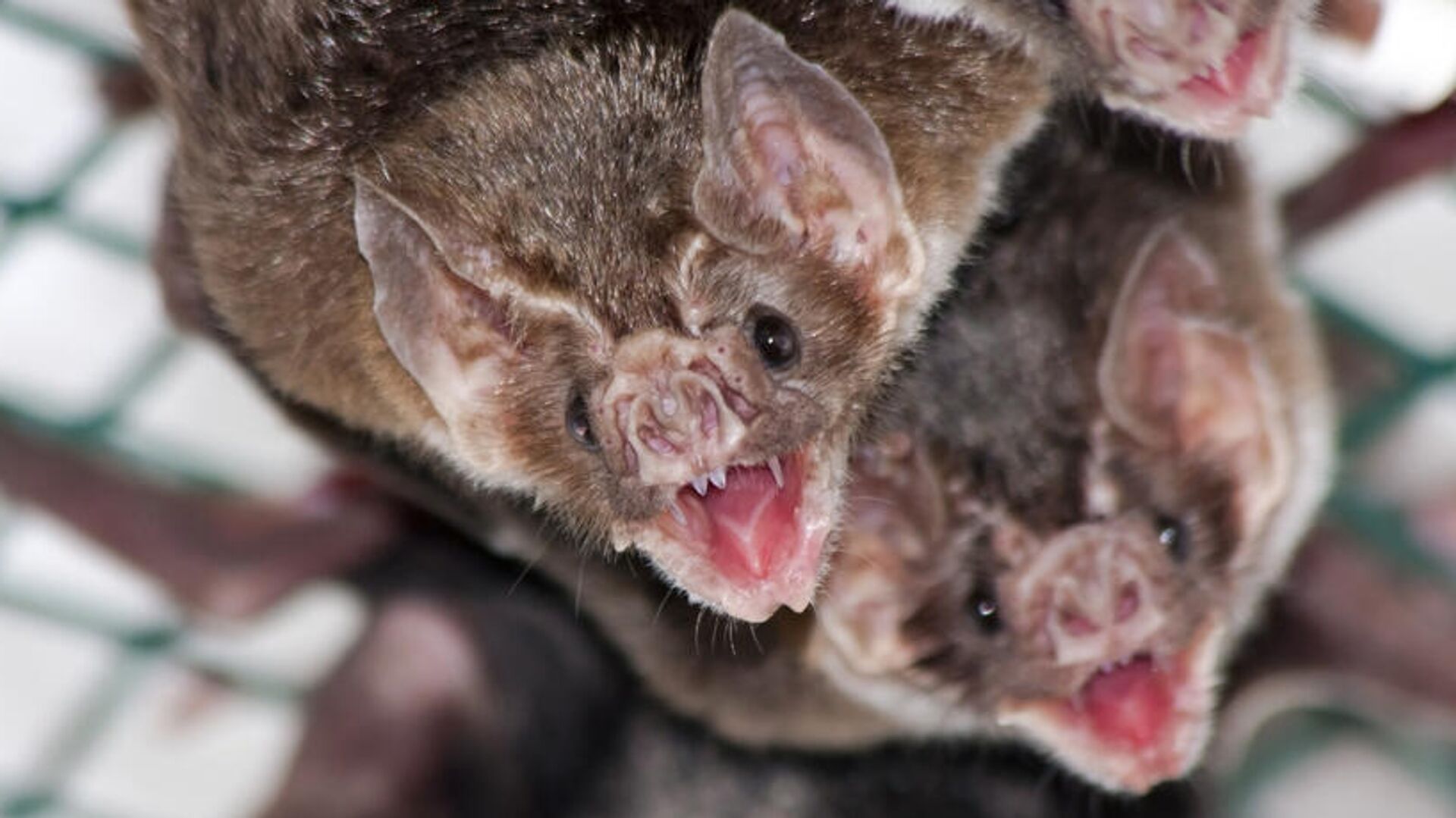https://sputnikglobe.com/20210924/drink-buddies-vampire-bats-share-their-blood-meals-with-friends-during-nocturnal-hunts-1089357617.html
Drink Buddies? Vampire Bats Share Their 'Blood Meals' With 'Friends' During Nocturnal Hunts
Drink Buddies? Vampire Bats Share Their 'Blood Meals' With 'Friends' During Nocturnal Hunts
Sputnik International
Vampire bats are unique creatures as they are the only mammals with a blood-only diet. Unlike other bat species, they can run exceptionally well. Their saliva... 24.09.2021, Sputnik International
2021-09-24T08:41+0000
2021-09-24T08:41+0000
2023-04-21T10:42+0000
hunting
animal kingdom
vampire bats
science & tech
https://cdn1.img.sputnikglobe.com/img/07e5/09/18/1089360976_22:0:840:460_1920x0_80_0_0_2de7a8cca08d9896b62589adbf5c9e8c.jpg
A new study by the Smithsonian Tropical Research Institute in Panama has revealed some quirky details about the social life of bloodthirsty vampire bats. The scientists found that these bats often have "friendly relationships" with each other while foraging for prey. Previous studies had revealed that these bats have a long-term relationship, and they groom, share "blood meals", and hang out together at the roost. However, it was unclear whether they interact outside the roost during their hunting rendezvous.The scientists, Gerald Carter, assistant professor of evolution, ecology, and organismal biology at The Ohio State University, and his former colleague Simon Ripperger attached small devices to 50 bats to track their foraging patterns in Panama. The pair chose female bats as they have stronger social relationships as compared to their male counterparts. Interestingly, out of these 50 bats, 23 were held captive for about two years during related research. Surprisingly, when these captive bats were released back into the wild, they often joined "friends" during foraging, and it is possible they were hunting together.Carter suspected that these bats generally hunt alone. Still, whenever they meet a "friendly" bat on any potential prey, they suck their blood together without fighting or flying off to find another target.The researchers also speculate that these bats may be exchanging information about the prey like location or access to the wound for blood. Vampire bats are found in the warmers regions of Latin America, and they live in colonies ranging from tens to thousands of individuals. The researchers reported their findings in PLOS Biology published on Thursday.
Sputnik International
feedback@sputniknews.com
+74956456601
MIA „Rosiya Segodnya“
2021
Sushmita Panda
https://cdn1.img.sputnikglobe.com/img/07e5/05/12/1082926186_0:0:2048:2048_100x100_80_0_0_4474d0d7e27a36878eb8727832be74b4.jpg
Sushmita Panda
https://cdn1.img.sputnikglobe.com/img/07e5/05/12/1082926186_0:0:2048:2048_100x100_80_0_0_4474d0d7e27a36878eb8727832be74b4.jpg
News
en_EN
Sputnik International
feedback@sputniknews.com
+74956456601
MIA „Rosiya Segodnya“
Sputnik International
feedback@sputniknews.com
+74956456601
MIA „Rosiya Segodnya“
Sushmita Panda
https://cdn1.img.sputnikglobe.com/img/07e5/05/12/1082926186_0:0:2048:2048_100x100_80_0_0_4474d0d7e27a36878eb8727832be74b4.jpg
hunting, animal kingdom, vampire bats, science & tech
hunting, animal kingdom, vampire bats, science & tech
Drink Buddies? Vampire Bats Share Their 'Blood Meals' With 'Friends' During Nocturnal Hunts
08:41 GMT 24.09.2021 (Updated: 10:42 GMT 21.04.2023) Vampire bats are unique creatures as they are the only mammals with a blood-only diet. Unlike other bat species, they can run exceptionally well. Their saliva has special proteins, and it is being used in medical trials for preventing blood clots.
A new study by the Smithsonian Tropical Research Institute in Panama has revealed some quirky details about the social life of bloodthirsty vampire bats. The scientists found that these bats often have "friendly relationships" with each other while foraging for prey.
Previous studies had revealed that these bats have a long-term relationship, and they groom, share "blood meals", and hang out together at the roost. However, it was unclear whether they interact outside the roost during their hunting rendezvous.
The scientists, Gerald Carter, assistant professor of evolution, ecology, and organismal biology at The Ohio State University, and his former colleague Simon Ripperger attached small devices to 50 bats to track their foraging patterns in Panama. The pair chose female bats as they have stronger social relationships as compared to their male counterparts.
Interestingly, out of these 50 bats, 23 were held captive for about two years during related research. Surprisingly, when these captive bats were released back into the wild, they often joined "friends" during foraging, and it is possible they were hunting together.
Carter suspected that these bats generally hunt alone. Still, whenever they meet a "friendly" bat on any potential prey, they suck their blood together without fighting or flying off to find another target.
"Biting a new wound can take 10 to 40 minutes. So sharing with a friend could save these bloodthirsty bats time and energy", Carter said.
The researchers also speculate that these bats may be exchanging information about the prey like location or access to the wound for blood. Vampire bats are found in the warmers regions of Latin America, and they live in colonies ranging from tens to thousands of individuals.
"People's first reaction to vampire bats is usually, 'Uh, scary'. But once you tell them about their complex social lives, they are quite surprised that we can find such behaviour that is somewhat similar to what humans do - and which one would maybe expect in primates - in bats", said study co-author Simon Ripperger, a Smithsonian Tropical Research Institute postdoctoral researcher.
The researchers reported their findings in
PLOS Biology published on Thursday.




